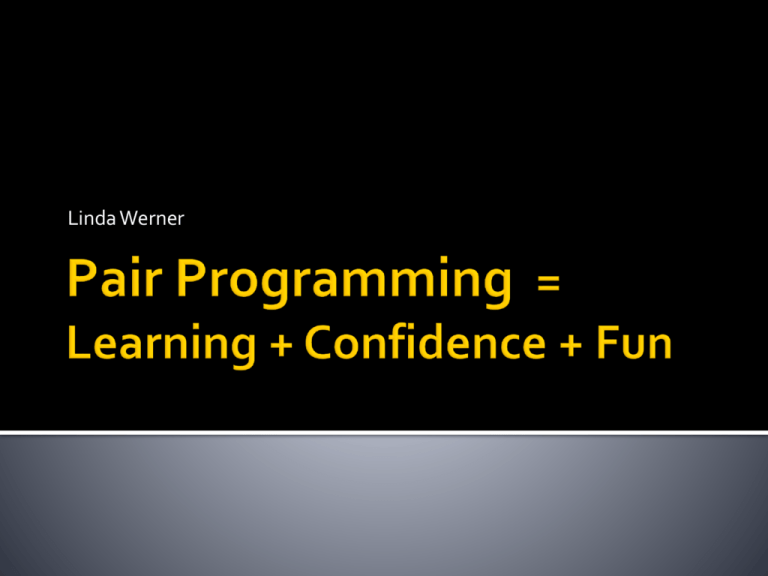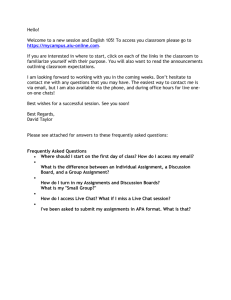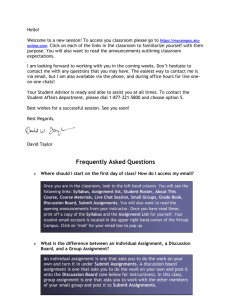Pair Programming
advertisement

Linda Werner Learn about using pair programming to 1. promote learning 2. increase students’ confidence 3. Increase students’ enjoyment Leave with at least one new idea about what you can do. 9 Ways to Get the Most out of Pair Programming in your High School Classrooms Ideas for getting students engaged and learning Charlie McDowell, Heather Bullock, Julian Fernald, and many graduate and undergraduate students Jill Denner, Shannon Campe, Eloy Ortiz To Get the Most out of Pair Programming Exercise – PairDraw – 30 minutes total Everyone participates first solo – 5 minutes then as a partner – 5 minutes Debrief – 20 minutes In industry: Two programmers work simultaneously on the same design, algorithm, code, or test using one computer Not divide-and-conquer Not one working and other sitting, doing nothing Specific roles: ▪ Driver – controls the mouse and the keyboard ▪ Navigator –follows along, contributes, ready to take control Both partners chat, pointing out things on the screen Programmers take turns in each role – saying “No, let me show you what I mean.” Extension to this called ‘Mob Programming’ In educational setting: Two students work simultaneously on the same problem on the computer or off Not divide-and-conquer Not one working and other sitting, doing nothing Specific roles on the computer: ▪ Driver – controls the mouse and the keyboard ▪ Navigator –follows along, contributes, ready to take control Both students chat, pointing out things on the screen Students take turns at each role using 10-15 minute blocks If one missing, partner gets them up-to-speed next time Teacher buys in to pair programming Teacher models good pair programming practices Does not take mouse or keyboard unless receives permission Points to the screen Verbally communicates Conducive environment Closed-lab sessions – if possible In-class group coding exercises Lab with room for 2 around each computer WHY? Partners working with friends learn more* Perform similarly on solo exams** Increased confidence in solutions** More fun** Higher program functionality and readability** Turn-in rate higher** Higher retention in field of study** *middle school **university HOW? Let students experiment in partnerships Name 3 others they could work with Teachers assign partnerships ▪ Based on this information ▪ Where partners have similar abilities ▪ Same gender partners (in most instances) NCWIT suggests Award a few pts for pair programming survey completion – contains evaluations for multiplier One example: 5% Survey 5% Class participation - clickers 10% Programming assignments 20% Online problems sets 30% In-class quizzes – best X out of Y 30% Exams (midterm and final) Why? Rubber-plant effect Expert programmer theory Self-explanation As the teacher, encourage this in your role as the ‘expert’ asking those ‘deep questions’ Count the number of times the people in the white shirts pass the ball VIDEO VIDEO2 “Given enough eyeballs, all bugs are shallow” Named Linus’ Law by Eric Raymond in “The Cathedral and the Bazaar” Person not typing picks up typos and other problems faster Code review is very effective – on par with test Take advantage of pair programming Let partners influence with ‘Pair Pressure’ Because partners don’t want to let their partner down Therefore, teach good practices Encourage small increments by writing your assignments this way Requiring a working version at each increment Name other good practices with your partner Host meetings before class registration Invite mentors from local colleges Invite students in current CS courses Invite math and science and art students AND their BEST FRIENDS to attend What other ways can you do INTENTIONAL RECRUITMENT? Change pairing to match interests Design programming assignments with room for experimentation See UCSC – Charlie McDowell’s– Draw something where program has to have at least 20 drawing commands See Georgia Tech - Mark Guzdial’s Media Computation course examples Why do students want to take this class? Friends Art/graphics/music Get more savvy Pair accordingly For projects 1. 2. 3. 4. 5. 6. 7. 8. 9. Know what it is (or isn’t) As the teacher, model good practices Students pick partners Evaluate using self and partner surveys Stimulate pair chat Celebrate partners’ differences Combat poor practices Do intentional recruitment Design assignment promoting creativity 1. 2. 3. 4. 5. 6. NCWIT – Pair Programming in a Box Mob Programming Pair Draw PairDraw Game by Arrizza Video from #6 Creative assignments 1. Charlie McDowell’s Processing assignment (get it now) 2. Mark Guzdial’s Media Computation 7. My publications including this presentation Linda Werner Linda@soe.ucsc.edu





